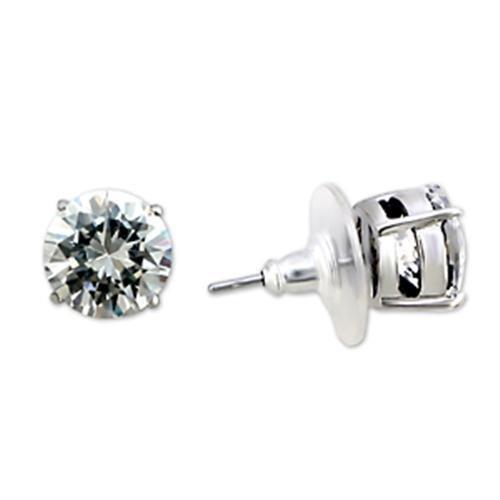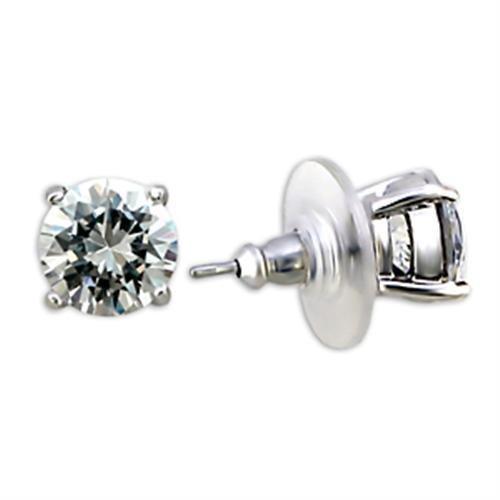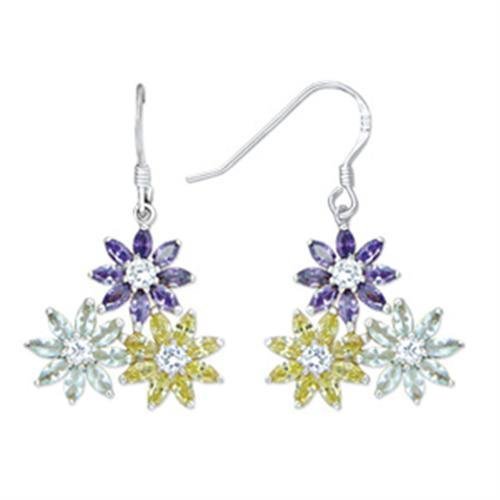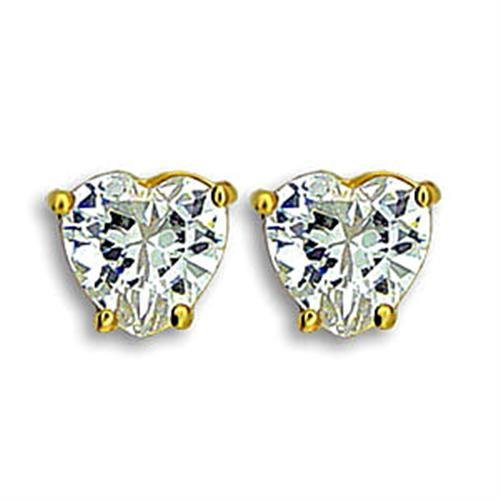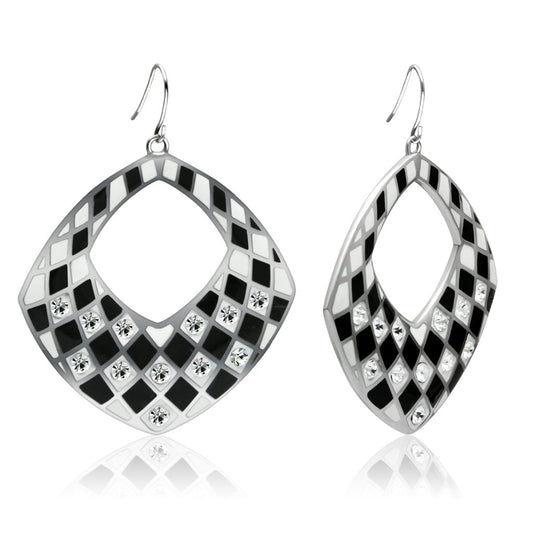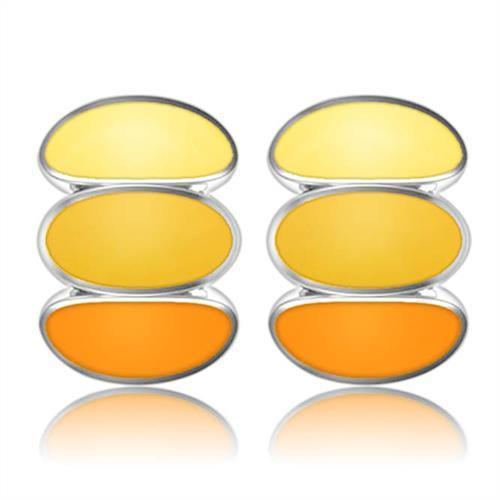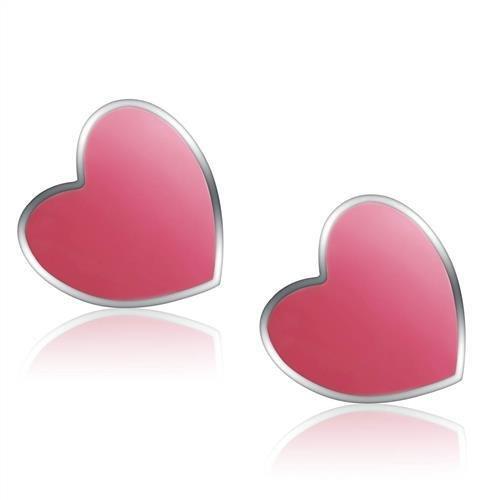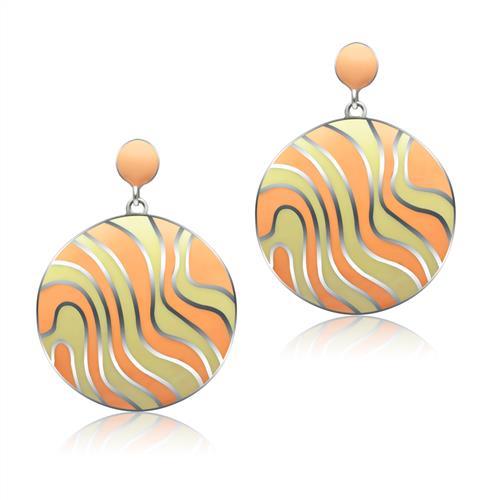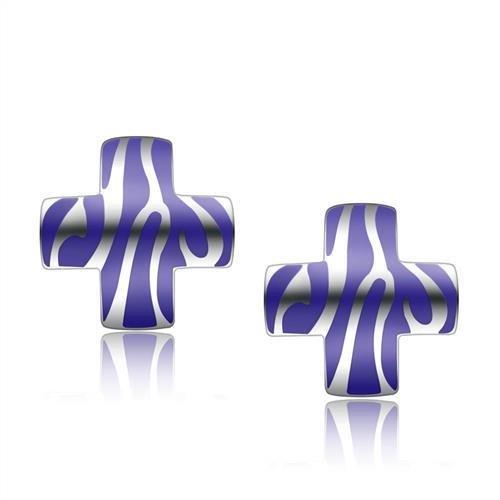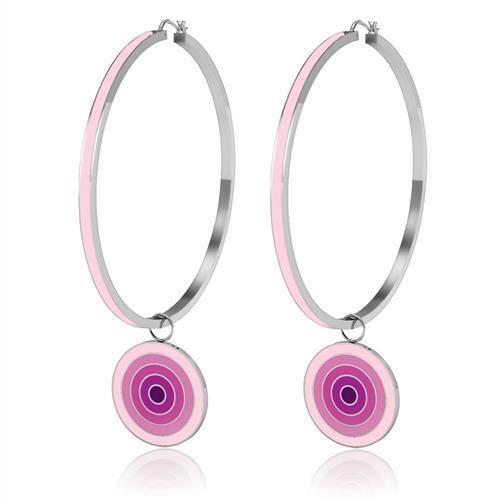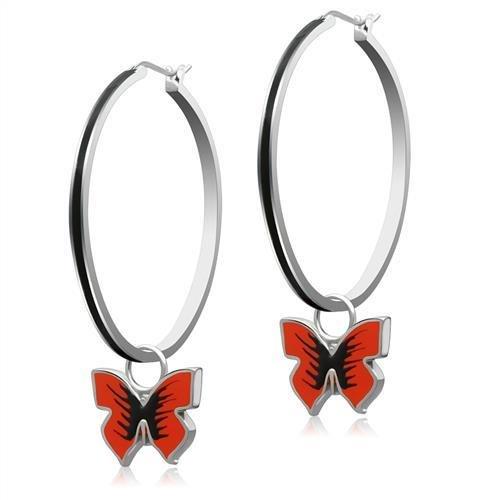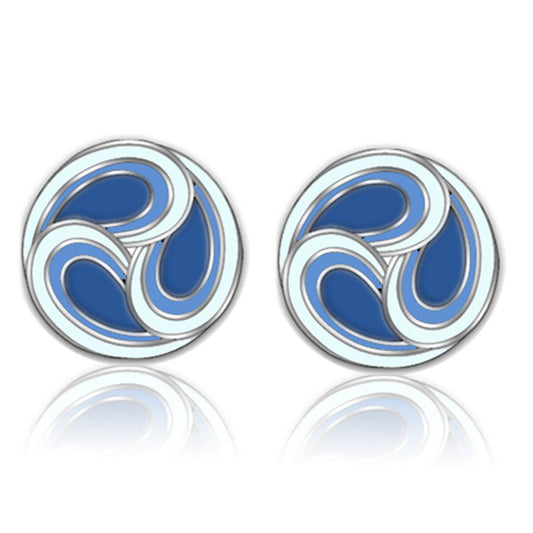We’ve all been there. You find a beautiful necklace, wear it a few times, and suddenly it’s a dull, dark shadow of its former self. That frustrating process is called tarnishing—a natural chemical reaction where metals clash with everyday elements like oxygen and sulfur, causing them to lose their sparkle.
So, what exactly is non-tarnish jewelry? It's jewelry crafted from metals that are highly resistant to this chemical reaction. These pieces either naturally fend off corrosion or are designed with protective layers to keep them looking pristine day after day.
This means they effortlessly resist damage from moisture, air, and even the natural oils from your skin. The result? Jewelry that stays bright and beautiful for far longer, making it a fantastic low-maintenance choice for daily wear.
The real promise here isn’t that this jewelry is indestructible, but that it’s thoughtfully designed for longevity. You get the look and feel of high-end accessories without the constant polishing or the disappointment of your favorite piece fading away.
This blend of durability and style has made non-tarnish pieces incredibly popular. As more people seek out beautiful accessories that actually last, the market has exploded. Today, it’s easier than ever to find high-quality, affordable options, with many stunning items available for just $10 to $15. You can dive deeper into this trend and its growth by checking out Salehoo's market analysis.
What to Expect from Different Materials
Of course, not all tarnish-resistant materials are created equal. They vary in durability, feel, and cost, which is great because it means there’s a perfect option for every taste and budget.
To help you navigate your choices, whether you're looking for a new ring or a bracelet from our collections at Precious Pulse Jewelry, here’s a quick rundown of the most common materials you’ll encounter.
Quick Guide to Tarnish-Resistant Materials
This table gives you a snapshot of the top contenders in the non-tarnish world, breaking down what makes each one special.
| Material | Key Benefit | Tarnish Resistance | Price Point |
|---|---|---|---|
| Stainless Steel (316L) | Hypoallergenic and extremely durable | Excellent | $$ |
| Titanium | Lightweight yet incredibly strong | Excellent | $$$ |
| Platinum | Naturally lustrous and highly resistant | Superior | $$$$ |
| Gold Vermeil | Thick gold layer over sterling silver | Good (with care) | $$$ |
From the rugged reliability of stainless steel to the luxe appeal of platinum, each material offers a unique way to keep your accessories shining. Understanding these differences is the first step to choosing pieces you’ll love for years to come.
The Best Materials for Tarnish-Free Jewelry
When it comes to picking out non-tarnish jewelry, the single most important decision you'll make is the material. It doesn't just define the look and feel of a piece; it dictates how well that piece will hold up to the hustle and bustle of your daily life. It’s time to move past generic labels and get into the nitty-gritty of what makes certain metals true performers, so you can find the perfect match for both your style and your budget.
This breakdown gives you a clear picture of how different materials stack up in the real world when it comes to durability and tarnish resistance.
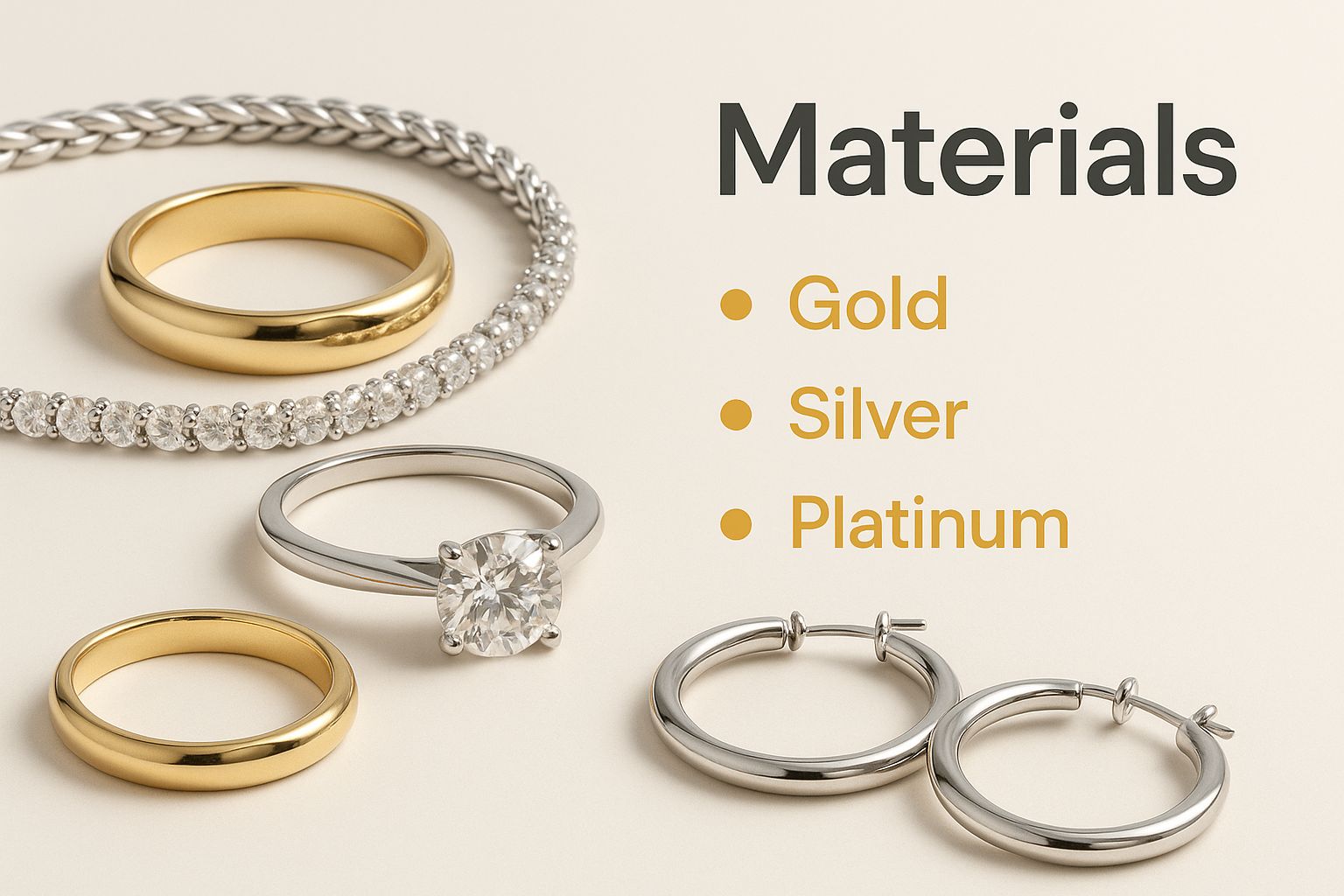
As you can see, premium metals like platinum and titanium sit at the top, offering unparalleled resistance. But right there in the sweet spot, you have fantastic options like stainless steel that deliver an incredible balance of toughness and affordability.
Stainless Steel: The Durable Workhorse
When you think of a metal that just won't quit, think 316L stainless steel, often called surgical-grade steel. This isn’t your average metal. It’s a seriously tough, corrosion-resistant alloy that also happens to be hypoallergenic, making it a go-to for anyone with sensitive skin.
Its natural resilience makes it a practical, worry-free choice for pieces you want to wear every single day. And people are catching on—the global stainless steel jewelry market was valued at $2.5 billion in 2024 and is expected to climb. This surge is all thanks to its incredible ability to fend off scratches, tarnishing, and fading. You can learn more about this trend by checking out the stainless steel market growth report at Business Research Insights.
Here at Precious Pulse Jewelry, our stainless steel pieces, from minimalist cuffs to everyday hoops, are designed to give you that lasting shine without the hefty price tag.
Titanium: The Lightweight Champion
Titanium is a true powerhouse, famous for its incredible strength-to-weight ratio. It's every bit as strong as steel but nearly 50% lighter. This makes it the perfect material for bigger, more dramatic statement pieces that won't feel like they’re weighing you down.
Just like stainless steel, titanium is highly biocompatible and hypoallergenic. Its cool, gray-silver luster is all-natural—no plating needed. Better yet, it forms a protective oxide layer that instantly repairs itself if it gets scratched, giving it continuous, built-in tarnish resistance.
Titanium’s unique blend of strength and lightness lets you wear bold, chunky designs that would feel uncomfortably heavy in other metals. It’s the ideal choice for a modern minimalist who values both form and function.
Platinum: The Pinnacle of Luxury
If you’re looking for the absolute best in luxury and longevity, platinum is it. As one of the densest and rarest precious metals on earth, it's treasured for its brilliant white luster that will never fade or change color over time.
Its inherent properties make it naturally resistant to both tarnish and corrosion. Platinum is also completely hypoallergenic, cementing its status as the superior choice for wedding bands and heirloom-quality jewelry designed to last a lifetime—and then some.
Gold Vermeil Versus Gold Plated
This is a common point of confusion for shoppers, but understanding the difference is crucial for getting your money’s worth.
- Gold Plated: This involves bonding a very thin layer of gold onto a base metal like brass or copper. That layer is often less than 0.5 microns thick and can wear away pretty quickly, exposing the metal underneath to air, moisture, and eventual tarnish.
- Gold Vermeil: This is the premium, more durable option. It requires a much thicker layer of real gold—a minimum of 2.5 microns—bonded over a base of genuine sterling silver.
That substantial layer of gold makes vermeil far more valuable and long-lasting than standard plating, giving you a rich, golden look that’s built to endure. When you're shopping, always check for the "925" stamp (indicating sterling silver) and a confirmation of the gold's thickness to be sure you’re getting true vermeil quality.
How to Keep Your Jewelry Looking Brand New
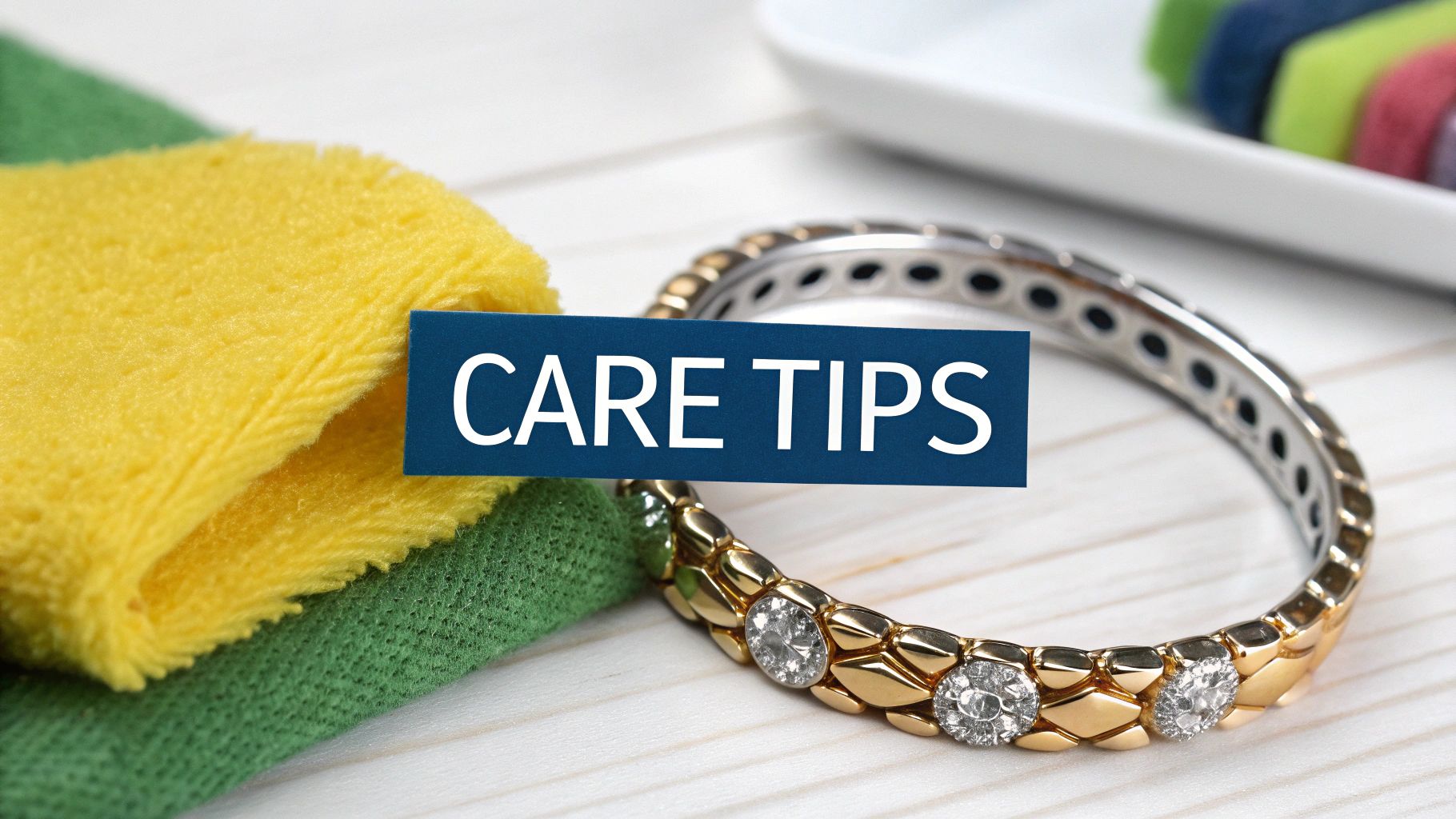
It’s a common myth that non-tarnish jewelry is completely indestructible. While it’s certainly built to last, a little bit of care goes a long way in keeping that brilliant, out-of-the-box shine for years to come. Think of it less as a chore and more as a simple ritual.
Your best defense against the gradual buildup of skin oils, lotions, dust, and daily grime is a consistent, gentle cleaning routine. This simple habit protects your investment and ensures your favorite pieces always look their best.
Your Simple Cleaning Routine
For most tarnish-resistant metals like stainless steel or titanium, a quick wipe-down with a soft, lint-free cloth after wearing is usually all you need. It’s the easiest way to handle fingerprints and oils before they have a chance to build up.
When you need a slightly deeper clean, mix a few drops of mild dish soap into a bowl of warm water. Dip a soft cloth in, gently wipe down your jewelry, then rinse it with clean water. The most important step? Dry it thoroughly with another soft cloth to prevent water spots.
Key Insight: Consistency is far more important than intensity. A gentle wipe after each wear is much better for your jewelry than an aggressive, infrequent scrub, which can cause micro-scratches over time.
This approach is perfect for tough metals, but some materials need a lighter touch. Gold vermeil, for example, has a thick layer of gold that should never be scrubbed aggressively. Likewise, sterling silver can oxidize, and cleaning it properly is key. For more detailed steps, check out our complete guide on how to clean sterling silver jewelry.
What to Avoid at All Costs
Protecting your jewelry is just as much about what you don’t do as what you do. To keep that brand-new luster, make sure your non-tarnish pieces stay far away from these common culprits:
- Harsh Chemicals: This is a big one. Think chlorine from pools, household bleach, and abrasive cleaners. These can eat away at the metal or cause permanent discoloration.
- Beauty Products: Make it a rule to put your jewelry on last. Lotions, perfumes, hairspray, and makeup should all be applied and allowed to set before you accessorize. Their chemical residues can create a film that dulls the shine.
- Excessive Moisture: A quick rinse is fine, but don't wear your jewelry in the shower, pool, or sauna. Prolonged exposure to water, steam, and humidity can be surprisingly damaging.
The Secret Weapon: Proper Storage
You’d be surprised how much damage happens when you’re not even wearing your jewelry. Tossing everything into a single drawer or bowl is a recipe for tangled chains and, worse, scratches.
The best habit you can form is to store each piece individually. A soft pouch or a jewelry box with lined compartments is ideal. This simple step prevents your accessories from rubbing against each other, which creates those tiny surface scratches that make metal look dull.
For an extra layer of protection, especially in humid climates, toss a silica gel packet into your jewelry box. It will absorb excess moisture from the air, making a huge difference in preserving the pristine condition of your collection.
Ready to find jewelry that lasts? Let's be honest—navigating the world of rings, necklaces, and bracelets can feel like a minefield, especially when you're trying to spot real quality among the cheap fakes.
The secret isn’t just about falling for a pretty design. It's about knowing what to look for underneath the surface. Arm yourself with a few insider tips, and you'll feel confident picking out non-tarnish jewelry that genuinely holds up.
The first clue is always in the product description. Vague promises like "tarnish-resistant coating" are a major red flag. You want specifics that point to solid craftsmanship and superior materials.
Decode the Details
When you're looking at a piece, pay close attention to the metal type mentioned. These aren't just technical terms; they're your best indicators of how durable and long-lasting the jewelry will be.
- For Stainless Steel: Look for the magic words "316L" or "surgical-grade." This specific alloy is a powerhouse, offering incredible corrosion resistance. It's also hypoallergenic, making it a dream for everyday wear.
- For Gold Vermeil: A quality description will always mention a sterling silver base. Crucially, it should also specify the gold's thickness—you want to see 2.5 microns or more. Anything less is just gold plating, which simply won't have the same staying power.
These details are what separate true non-tarnish jewelry from pieces that look great for a week and then fade.
The Importance of Hallmarks
Think of hallmarks as a secret decoder ring for quality. These tiny stamps on jewelry are marks of authenticity, telling you exactly what a piece is made of. Learning to spot them is one of the easiest ways to verify you're getting the real deal.
A critical hallmark to know is “925.” This stamp is your guarantee that the piece is genuine sterling silver, meaning it contains 92.5% pure silver. It's a globally recognized standard of quality. If a seller markets something as sterling silver but it's missing this stamp, it’s a good reason to be skeptical. To get the full story, you can explore the key differences between silver and sterling silver in our detailed guide.
Checking for hallmarks is one of the quickest and most reliable ways to verify the quality of a metal. It’s a small detail that provides a big assurance about your purchase.
Your Quality Checklist
Whether you're browsing online here at Precious Pulse Jewelry or out shopping in person, keep this simple checklist in mind. It will help you evaluate any potential purchase like a pro.
- Check the Finish: A high-quality piece should feel smooth and look even. Run your fingers over it—you shouldn't find any rough spots, visible seams, or patches of discoloration.
- Test the Clasp: Open and close the clasp a few times. Does it feel secure? Is it easy to operate without feeling flimsy? A weak clasp is often the first thing to fail on a cheap piece of jewelry.
- Evaluate the Feel: Quality has weight. If a piece feels surprisingly light or plasticky for its size, that's often a sign that it’s made from lower-grade, cheaper materials.
By putting these simple checks into practice and carefully reading the product details, you can confidently choose beautiful, durable non-tarnish jewelry that will stay brilliant for years to come.
Why Durable Jewelry Is a Global Trend

Have you noticed that high-quality, long-lasting jewelry seems to be everywhere lately? It’s not just you. This surge in popularity for non tarnish jewelry is part of a much bigger global shift in how we think about fashion, value, and personal style.
Younger generations, especially Millennials and Gen Z, are at the forefront of this change. They’re consciously moving away from the “fast fashion” cycle of disposable items and embracing a more thoughtful approach. Instead of buying pieces that lose their shine after just a few wears, they're choosing to invest in accessories that promise durability and timeless appeal.
This movement is all about smarter consumption. People want the look and feel of fine jewelry without the hefty price tag or constant upkeep, and non-tarnish pieces perfectly bridge that gap.
A Worldwide Shift in Style and Spending
This isn’t just some fleeting fashion moment; it's a worldwide trend with serious market growth behind it. The rise of e-commerce and social media has been a game-changer, making stylish and durable jewelry from brands like Precious Pulse Jewelry more accessible than ever. One quick scroll through Instagram or TikTok makes it clear: people want accessories they can wear every single day without them fading or tarnishing.
This demand points to a major change in what we prioritize as consumers. The global jewelry industry is huge, projected to climb to around USD 370 billion in 2025. A big piece of that growth is coming from the demand for affordable yet lasting options. In fact, North America’s demi-fine jewelry market alone is expected to hit US$ 2.1 billion by 2025. If you want to dive deeper into the numbers, you can explore the latest jewelry industry statistics.
Ultimately, choosing non-tarnish jewelry is more than a style choice—it's about aligning with a global movement toward value, quality, and sustainability. It represents a smarter way to build a collection, where durability is just as important as the design. This focus on long-lasting style isn't just a trend; it's reshaping the entire industry for the better.
Common Questions About Non-Tarnish Jewelry
Even after getting the hang of what non-tarnish jewelry is all about, a few practical questions almost always pop up. Getting those answered is the final step to feeling totally confident in your choice, so you can pick pieces that truly fit your life. Let's dig into the questions we hear most often.
Can I Shower or Swim with Non-Tarnish Jewelry?
This is easily one of the most common questions, and our honest advice is always to play it safe. While super-durable materials like 316L stainless steel and titanium are built to handle water, it’s everything else in the water that can cause problems down the road.
Think about it: soaps, shampoos, and conditioners can leave behind a dull film that slowly builds up on the surface of your jewelry. Worse, the chlorine in pools and the salt in the ocean are naturally corrosive and can, over time, eat away at the finish of even the toughest metals. That’s why we always suggest taking your pieces off before you hop in the shower or go for a swim. It’s the best way to keep them looking brilliant for years to come.
Does Gold Vermeil Tarnish Over Time?
It’s a fair question, but there's a common misconception here. Pure gold itself is a noble metal, meaning it doesn't tarnish. Gold vermeil isn't pure gold, though—it's a thick, heavy layer of real gold bonded over a sterling silver core. This process creates a beautiful and durable piece, but it isn’t completely invincible.
If the piece sees many, many years of hard wear or gets a deep scratch, it's theoretically possible for the gold layer to wear down. Should that happen, the sterling silver underneath could be exposed to air and start to oxidize (tarnish). The key takeaway here is that proper care dramatically extends its life, making it a far more valuable and resilient choice than standard gold plating. To really get a grip on this, it helps to know the basics of why discoloration happens in the first place; you can learn more about what causes jewelry to tarnish in our detailed article.
The Takeaway: While technically possible under extreme conditions, tarnishing is not a typical concern for well-cared-for gold vermeil. Its thick gold layer provides a robust shield that protects the silver core for years.
How Can I Tell if My Jewelry Is Real Stainless Steel?
Spotting genuine, high-quality stainless steel is a great skill to have, and it only takes a few simple checks. Knowing what to look for ensures you’re getting the quality you’re paying for.
Here are a few tell-tale signs:
- Look for a Hallmark: The most reliable method is to check for a stamp. High-quality, surgical-grade stainless steel is often marked with "316L."
- Try the Magnet Test: Grab a small magnet and see what happens. Real, high-grade stainless steel (like 316L) is either not magnetic at all or only very weakly magnetic. If the magnet latches on tight, you might be looking at lower-quality steel or another metal entirely.
- Feel the Weight and Notice the Color: Quality stainless steel has a satisfying heft to it. It also has a slightly darker, grayish undertone when you compare it to the bright, almost-white shine of sterling silver.
Is Non-Tarnish Jewelry Safe for Sensitive Skin?
Yes, absolutely—but the material you choose is everything. For anyone with skin sensitivities or known metal allergies, picking the right type of non-tarnish jewelry is the most important step to avoiding irritation.
The safest, most recommended options are metals known for being hypoallergenic. Your best bets are:
- Surgical-Grade Stainless Steel (316L): This metal was specifically engineered to be biocompatible, and it's celebrated for being nickel-free.
- Titanium: Another fantastic choice, titanium is completely nickel-free and stands as one of the most hypoallergenic metals you can find.
- Platinum: While it’s a more premium material, platinum is also naturally hypoallergenic and incredibly gentle on the skin.
Always make it a habit to double-check the product description to confirm the base metal. It’s a simple step that guarantees you can wear your new favorite pieces comfortably and confidently, without a worry in the world.
Ready to find your next favorite piece? Explore the stunning and durable collections at Precious Pulse Jewelry, where you’ll discover beautiful non-tarnish accessories designed to last. https://preciouspulsejewelry.com


